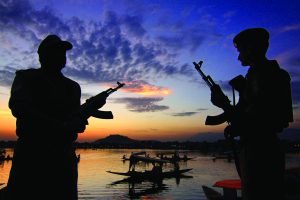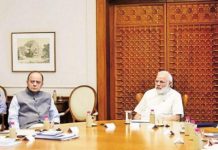 Around 600 shikarahs (boats) moored at over 30 ghats along Srinagar’s Dal lake wait endlessly for tourists. So do the 900 houseboats anchored to other side of the lake. Boatmen while away their time on the banks. But there are no tourists in Kashmir Valley who could be expected to visit Dal. “We haven’t earned a penny in the past four months,” says Mohammad Yaseen Dar, a boatman. “No tourists are visiting the Valley”.
Around 600 shikarahs (boats) moored at over 30 ghats along Srinagar’s Dal lake wait endlessly for tourists. So do the 900 houseboats anchored to other side of the lake. Boatmen while away their time on the banks. But there are no tourists in Kashmir Valley who could be expected to visit Dal. “We haven’t earned a penny in the past four months,” says Mohammad Yaseen Dar, a boatman. “No tourists are visiting the Valley”.
State Government ordered the tourists to leave Kashmir on August 3, two days before New Delhi scrapped Article 370 which granted Kashmir autonomy within Indian Union. The flight followed a government order calling upon tourists and the pilgrims to the annual Amarnath pilgrimage to cut down their visit and leave the Valley within 24 hours. The state Government buses were pressed into service to ferry tourists and pilgrims from across Kashmir and rush them to Srinagar airport and bus terminals to facilitate their exit.
Within two days, Kashmir was empty of all the outsiders, something that has inflicted a crippling blow on the state’s tourism industry during its peak season. More than 340,000 tourists, including an estimated 200,000 yatris on the annual Amarnath Yatra pilgrimage fled the Valley. Hotels which until then enjoyed 80 percent occupancy have turned into ghost houses, among them premium hotels in famous scenic resorts of Gulmarg and Pahalgam whose rooms went for as much as 25000 a night in June and July.
However, while two months later, the government lifted the advisory on the visitors to the Valley, the tourists aren’t coming. The reason for this is that Kashmir remains far from normal. While traffic plies on the roads and markets open in the morning and evening, creating a semblance of normalcy, the Valley remains anything but normal. An eerie calm prevails, so fragile that everyone expects it give in sooner than later. Prepaid phones and Internet remain suspended, something that is discouraging the potential tourists to visit the Valley.
Tourism is one of the pillars of Kashmir economy, employing thousands of people who have now been rendered jobless. This is making the people associated with the trade curse their fate. 2019, they say, has turned out to be one of the worst years for them.
And this certainly seems to be the case. Beginning February, nothing has gone right for the Kashmir tourism and in turn the state’s economy. As the beginning of the year started bringing tourists back to Valley, an escalation in India-Pakistan tension following Pulwama bombing sent tourists packing and dissuaded people planning to visit to defer their programme. Although by June, the situation had improved a great deal and the tourists had started returning, the repeal of Article 370 put paid to a promising season. In less than two days, Kashmir was empty of all the visitors. This has hit the traders hard. And if the situation goes on like this for months to come, it will deal another big blow to Valley’s economy after the one inflicted by the unrests of recent years.
“Mere lifting of advisory by the government will not do. It has to be urgently followed by the subsequent steps like restoring of prepaid mobile phones and the internet,” says Ishfaq Ahmad Shah, a hotel owner. “But the government has been shying away from this. This is
unlikely to work”.
There are no separate figures about how much loss the tourism industry has suffered over the past four months. Even the minister of state for home affairs G. Kishan Reddy in response to questions in the Parliament recently had no data on the losses suffered by tourism industry, even while he provided overall number of tourists who visited the Valley in past six months. He also didn’t give any specific number of visitors to Kashmir since the lifting of a travel advisory in October.
letters@tehelka.com












